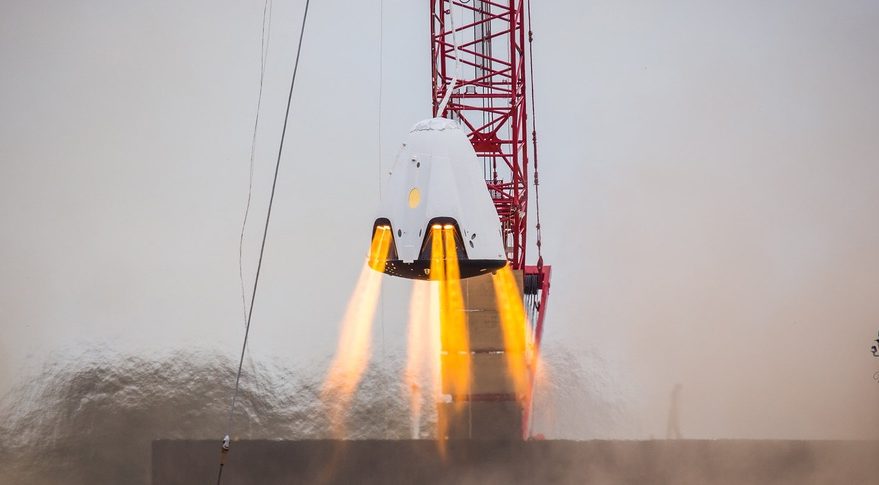SpaceX Says Faulty Valve Led to Crew Dragon Test Accident

WASHINGTON — SpaceX said July 15 that the explosion that destroyed a Crew Dragon spacecraft during a ground test in April was likely caused by oxidizer that leaked into the spacecraft's propulsion system and destroyed a valve, but didn't give a firm schedule for resuming test flights.
The April 20 explosion at Cape Canaveral took place during testing of the thrusters on the same Crew Dragon spacecraft that flew the uncrewed Demo-1 mission to the International Space Station in March. SpaceX was testing the thrusters, including both the smaller Draco thrusters and larger SuperDraco thrusters, ahead of an in-flight abort test of the spacecraft then planned for this summer.
According to SpaceX, all the Draco thrusters were tested successfully but, about a tenth of a second before the scheduled ignition of the SuperDraco thusters, the anomaly took place that destroyed the spacecraft. There were no personnel in the vicinity of the vehicle at the time of the test and thus no injuries.
Related: SpaceX Dragon Accident a Bump in the Road for Commercial Crew
SpaceX said the most likely cause of the explosion was when a "leaking component" allowed nitrogen tetroxide (NTO) oxidizer into helium tubes during processing. When the system was pressurized just before the planned ignition, a "slug" of NTO was driven at high speed into a titanium check valve, causing structural failure of the valve and igniting it, triggering the explosion.
"When you pushed the slug [of NTO] into the check valve, it basically creates an explosion," said Hans Koenigsmann, vice president of build and flight reliability at SpaceX, during a call with reporters.
He said SpaceX, with the assistance of NASA, confirmed this scenario in testing at the company’s McGregor, Texas, test site. "We found out that when the pressure is pretty high, the temperature is high, and you drive a slug with a lot of energy into a titanium component, you can have these rather violent reactions," he said.
Get the Space.com Newsletter
Breaking space news, the latest updates on rocket launches, skywatching events and more!
While the investigation is continuing — Koenigsmann said the company has worked through about 80% of the "fault tree" of potential causes of the explosion — it was already taking steps to address this likely cause. The check valves, which can leak, will be replaced with burst disks that remain sealed until they reach a certain pressure.
"That is exactly the application we need for the escape system," he said of burst disks. "I feel like this is actually the better component."
Kathy Lueders, manager of NASA's commercial crew program, called the accident a "huge gift" for the agency, and for SpaceX, since it discovered the flaw in a ground test. "We had the ability to find an issue with the hardware and be able to find the hardware and be able to assess the hardware," she said. "We will continue to learn things to help us fly safer."
Amid criticism about how NASA and SpaceX publicly communicated information about the anomaly with the public, Lueders noted that NASA personnel were on console for the test and knew immediately what happened. She also praised SpaceX for its work on the investigation, and that now was the time to "be transparent" about the status of the investigation.
Neither Koenigsmann nor Lueders would commit to a schedule for resuming test flights of the Crew Dragon spacecraft, including both the in-flight abort and the Demo-2 mission, which will carry NASA astronaut Bob Behnken and Doug Hurley. Prior to the accident the Demo-2 mission was officially scheduled for late summer, but most industry observers expected it to slip to late in the year.
Koenigsmann said work like replacing check valves with burst disks can be done at the same time as other activities that need to be completed prior to NASA’s approval for the Demo-2 flight, like completing testing of parachutes. “It’s a parallel path, basically, to solving the remaining work that we have on Dragon in general,” he said.
Both said that the Demo-2 flight could still take place before the end of the year, although Koenigsmann acknowledged it was "increasingly difficult" to keep that flight scheduled for this year.
"There's always a chance we're going to fly crew on a SpaceX vehicle this year," Lueders said. "Right now we're paying very close attention to the work that's being done, coming out of the anomaly investigation, along with the other tests." She said that Behnken and Hurley had been briefed "multiple times" on the investigation during their regular visits to SpaceX.
"We're going to fly when we feel like the certification work has been done to be able to safely fly our crews," she added. "I hope it's this year, but we're going to fly when it's the right time and when we know we'll be flying our crews safely."
- SpaceX's Crew Dragon Demo-1 Test Flight in Pictures
- In Photos: A Behind-the-Scenes Look at SpaceX's Crew Dragon Spaceship
- The Emergency Launch Abort Systems of SpaceX and Boeing Explained
This story was provided by SpaceNews, dedicated to covering all aspects of the space industry.
Join our Space Forums to keep talking space on the latest missions, night sky and more! And if you have a news tip, correction or comment, let us know at: community@space.com.

Jeff Foust is a Senior Staff Writer at SpaceNews, a space industry news magazine and website, where he writes about space policy, commercial spaceflight and other aerospace industry topics. Jeff has a Ph.D. in planetary sciences from the Massachusetts Institute of Technology and earned a bachelor's degree in geophysics and planetary science from the California Institute of Technology. You can see Jeff's latest projects by following him on Twitter.










